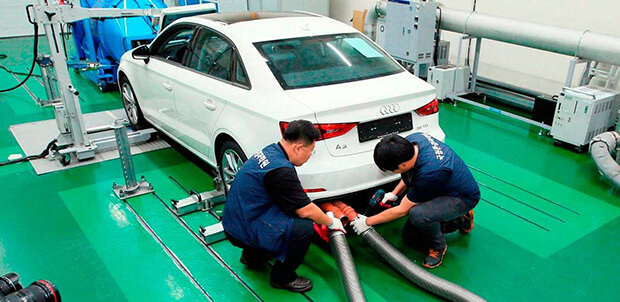Car prices and motor tax is set to rise again

A new system for testing fuel economy and fuel emissions of cars is sound but it will come at a price
The proposed changes to the tests for emissions and fuel economy in new cars are likely to result in higher car prices and increased motor tax according to some.
The new vehicle test procedure, known as the Worldwide Harmonised Light Vehicles Test Procedure (WLTP), will replace the long-established New European Driving Cycle (NEDC).
The NEDC test has been criticised repeatedly in the past for its inability to reflect real-world fuel economy.
It has been observed that there is a gulf between what can be achieved on the road, in real-world conditions and the results from ideal laboratory test conditions.
Eight separate studies concluded that the gap between the certified and actual levels had widened, on average, from 8pc in 2001 to 38pc in 2013.
As a result of these inaccuracies, consumers end up paying more at the pump for their fuel, while at the same time, the Government is missing out on revenue due to unreliable CO2 figures.
The new test will be more accurate than the previous test and it is expected that fuel economy figures will decline and CO2 emissions will increase.
This situation is likely to cause a lot of confusion among prospective car buyers as new cars will appear to be less efficient than older ones.
With the introduction of the new test, the choice of car options may also shrink as a result, since, for the first time, optional extras will also have an impact on the car's CO2 rating. This means that it is possible that two identical cars but with different options may find themselves in a different motor tax band.
This may change the way consumers value options and the number of them available. Currently, only wheel size, number of seats and the choice of manual or automatic transmission impact on CO2 levels, whereas now all available options from air-conditioning to a sunroof will make a difference.
This could potentially lead to an increasingly complex system resulting in possibly thousands of different CO2 figures depending on the number, type and combinations of options chosen.
The managing director of the International Council on Clean Transportation Europe, Peter Mock, believes that a more streamlined approach to options is likely. He said:
"Now with WLTP, each vehicle model version will receive its specific CO2 emissions level, so one might expect that the manufacturers will now spread the different optional equipment more between the various vehicle model variants."
What the impact of the new test with the higher CO2 levels will have on the motor tax system, has yet to be seen?
At the moment very little is known about how the WLTP will work with regard to motor taxes and the different bands, but it is certain that the value for CO2 will be higher than with the present testing system.
A rise in CO2 will lead to cost increases across all models due to higher VRT and motor tax rates.
The test will only apply to new car models introduced for the first time from this September, but all new cars sold in Europe will be subject to the test from September 2018.
The EU is advising that countries like Ireland, in which the motor tax system is based on CO2 levels, should amend their systems so that any additional costs are not passed on to the consumer.
New car sales are already down almost 10pc so far this year, any increase in motor tax on new cars could have a negative impact on sales.
The director general of the Society of the Irish Motor Industry, Alan Nolan, said that the test was "good news for the environment and in assisting us in Ireland to try and reach our emissions targets as the information on these newer cars will be far more accurate than we have had in the past", it was important that the changes did not "simply lead to consumers paying more tax on what will be cleaner vehicles".
But what of older cars with inaccurate CO2 emission levels? From September 1 until January 2019, both the old NEDC figure and the new WLTP values will be available for new cars, so the gap between them will be clearly identifiable to all, including prospective buyers and the Government.
All cars bought before September 1, 2017 will have been tested under an inaccurate system,which most likely has underestimated CO2 emission figures, these figures will be "readjusted" for motor tax purposes in order to correlate to the new, more accurate figures?
A Department of Finance spokesperson told the Sunday Independent that "tax policy and operational implications" arising from the new system were being considered and the department "will be liaising with other relevant authorities in this regard".
The new test may be going in the right direction, considering all the controversy of the emissions scandal over the past few years, it is still not going to give fully accurate figures for consumers.
Julia Poliscanova, the clean vehicles and air quality manager at the European Federation for Transport and Environment said,
"an average EU driver will still use around 20pc more fuel than the new lab test will claim after September".
The European Federation for Transport and Environment is recommending that in order to close this gap real-world tests conducted on public roads must be incorporated into the test.
(As always, if you or a family member are considering buying a used car, don’t buy until you run a car check report with MyVehicle.ie where you will find out the true history of the vehicle.)

Author

Justin Kavanagh
Justin Kavanagh is a recognised leader
in automotive intelligence and vehicle
data supply to the entire motor industry.
He has almost 20 years experience in
building systems from the ground up.
As the Managing Director of Vehicle
Management System, he understands the
need and importance of trustworthy and
reliable vehicle history and advice to
both the trade and the public.
Follow me on LinkedIn